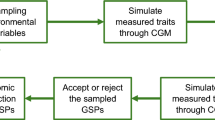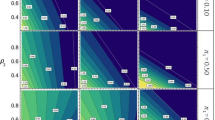Summary
The ability to predict agronomic performance of progeny from a cross would be a great benefit to plant breeders in selecting parents. The predictive value of parental genetic relationships estimating F1 progeny means and F4 family variances of nine argronomic traits was tested in 76 oat crosses, using genetic distance measures based on coefficients-of-parentage, quantitatively inherited morphological characters, and discretely inherited biochemical and morphological characters. Coefficients-of-parentage were better predictors of F1 performance than similarity measures derived from plant morphology or discretely inherited characters. Combined distance measures were better estimators of F1 specific combining ability (SCA) effects than any single measure. Among cultivars of similar adaptation and quantitative morphology, crosses between parents with high coefficients-of-parentage gave higher SCA effect values than crosses of distantly related parents for grain yield and total biomass. The opposite was found for crosses among cultivars of different adaptation or quantitative morphology. The best predictor of trait variances among F4 families was coefficients-of-parentage. Crosses between more distantly related parents produced larger variances among families than crosses between closely related parents for plant biomass. For grain yield, test weight, heading date, grain filling period, and maturity date, crosses between more closely related parents produced larger among-family variances than crosses of distantly related parents. Crosses between more distantly related parents involved at least one parent unadapted to central New York, and resulted in most of the progeny being generally unadapted. This, in part, may account for the low genetic variances for heading date, test weight, and grain yield in crosses of distantly related parents.
Similar content being viewed by others
References
Comstock RE, Robinson HF (1948) The components of genetic variance in populations of biparental progenies and their use in estimating the average degree of dominance. Biometrics 4:254–256
Cowen NM, Frey KJ (1987a) Relationships between three measures of genetic distance and breeding behavior in oats (Avena sativa L.). Genome 29:97–106
Cowen NM, Frey KJ (1987b) Relationships between genealogical distance and breeding behavior in oats (Avena sativa L.). Euphytica 36:413–424
Cox TS, Murphy JP (1990) The effect of parental divergence on F2 heterosis in winter wheat crosses. Theor Appl Genet 79:241–250
Damerval C, Hebert Y, D Vienne de (1987) Is the polymorphism of protein amounts related to phenotypic variability? A comparison of 2D electrophoresis data with morphological traits in maize. Theor Appl Genet 74:194–202
Dobzhansky T (1952) The nature and origin of heterosis. In: Gowen JW (ed) Iowa State University Press, Ames, pp 218–223
Frei OM, Stuber CW, Goodman MM (1986) Use of allozymes as genetic markers for predicting performance in maize single cross hybrids. Crop Sci 26:37–42
Horner TW, Weber CR (1956) Theoretical and experimental study of self-fertilized populations. Biometrics 12:404–414
Jenkins G (1969) Heterosis and combining ability in hybrids of Avena sativa L. and A. byzantina C. Koch. J Agric Sci 72:85–92
Jinks JL, Pooni HS (1981) Properties of pure-breeding lines produced by dihaploidy, single seed descent, and pedigree breeding. Heredity 46:391
Lamkey KR, Hallauer AR, Khaler AL (1987) Allelic differences at enzyme loci and hybrid performance in maize. J Hered 78:231–234
Martinez OJ, Goodman MM, Timothy DH (1983) Measuring racial differentiation in maize using multivariate distance measures standardized by variation in F2 populations. Crop Sci 23:775–781
Moll RH, Lonniquist JH, Velez Fortuno J, Johnson EC (1965) The relationship of heterosis and genetic divergence in maize. Genetics 52:139–144
SAS Institute (1985) SAS users guide: statistics, 5th edn. SAS Institute Inc, Cary/NC
Shamsuddin AKM (1985) Genetic diversity in relation to heterosis and combining ability in spring wheat. Theor Appl Genet 70:306–308
Smith JSC (1984) Genetic variability within U.S. commercial hybrid maize (Zea mays L.): multivariate analysis of allozyme data. Crop Sci 24:1041–1046
Snedecor GW, Cochran WG (1980) Statistical methods, 7th edn. Iowa State University Press, Ames
Souza E (1988) Measures and applications of genetic relationships in oat. PhD thesis Cornell University, Ithaca/NY (Diss. Abstr. 88–21228)
Souza E, Sorrells ME (1989) Pedigree analysis of North American oat cultivars released from 1951 to 1985. Crop Sci 29:595–601
Souza E, Sorrells ME (1991a) Relationships among 70 North American oat germ plasms. I. Cluster analysis using quantitative characters. Crop Sci 31: No 4
Souza E, Sorrells ME (1991 b) Relationships among 70 North American oat germ plasms. II. Cluster analysis using qualitative characters. Crop Sci 31: No 4
Author information
Authors and Affiliations
Additional information
Communicated by A. R. Hallauer
Rights and permissions
About this article
Cite this article
Souza, E., Sorrells, M.E. Prediction of progeny variation in oat from parental genetic relationships. Theoret. Appl. Genetics 82, 233–241 (1991). https://doi.org/10.1007/BF00226219
Received:
Accepted:
Issue Date:
DOI: https://doi.org/10.1007/BF00226219




